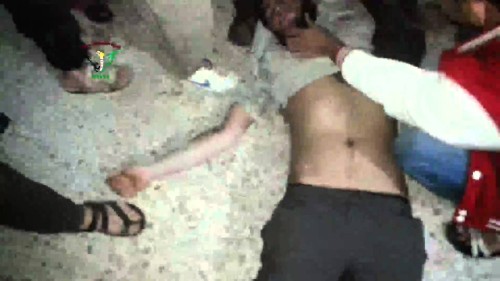PHOTO: Victims of chlorine attack in Kafrzita in Hama Province, March 2014
LATEST
FRIDAY FEATURE
Interview: Assad Blames Idlib Defeat on “Outside Powers” — “Sometimes You Win, Sometimes You Lose”
In a closed-door session on Thursday, the UN Security Council heard first-hand accounts from Syria’s doctors of the Assad regime’s chemical weapons attacks.
The Council also watched video of the doctors struggling to save children who were vomiting and choking.
One of the doctors, Dr Zaher Sahloul of the Syrian American Medical Society, spoke about the treatment of victims of a chlorine attack in March on Sarmin, near Idlib, in northwest Syria:
Doctors and nurses were struggling to treat them. They all had respiratory symptoms, they had coughs, they had wheezing, some of them had fluid in their lungs.
Another doctor, Mohamed Tennari, said:
The patients had a severe shortness of breath, coughing, wheezing, irritation of the throat and eyes, vomiting and foaming … everyone smelled bleach odour in the air and heard the sounds of helicopters hovering in the skies.
The people in my city [Idlib] and in Syria expect the Security Council to act. We have been dying every day from missiles and barrel bombs — and now toxic agents. Our message to the international community is: please stop this in Syria.
US Ambassador Samantha Power told reporters that members became “very, very emotional” while watching the video: “If there was a dry eye in the room, I didn’t see it.”
Washington has led the effort to condemn the regime for the chemical attacks, which most recently have come through chlorine canisters in barrel bombs. Power said that the Council will now seek to identify those behind the attacks and ensure they face justice.
Power reiterated, “All the evidence shows that [the attacks] come from helicopters — only the Assad regime has helicopters.”
On March 6, the Council passed a resolution expressing “extreme concern” about the attacks and authorizing “Chapter 7” measures, such as economic restrictions, against anyone found responsible for further use of chemical weapons. However, Russia — a key supporter of the Assad regime — is likely to block any action.
The Assad regime was able to avoid punishment, including military intervention, after its sarin attacks in August 2013 killed close to 2,000 people in the East Ghouta area near Damascus. It promised to hand all chemical weapons stocks for destruction.
However, because of its common domestic uses, chlorine is not classified as a chemical weapon.
Since spring 2014, Syrian warplanes have been accused of using chlorine on a number of occasions in Idlib and Hama Provinces. The Organization for Prohibition of Chemical Weapons found “strong evidence” that helicopters dropped canisters in March and April 2014, killing at least 14 people and wounding hundreds, and again in August.
This week, Human Rights Watch reported on the evidence indicating the regime’s dropping of chlorine last month near Idlib on up to seven occasions, trying to check a rebel advance that eventually took the provincial capital. Six members of a family, including three children, died and more than 100 people were wounded.
Video: Rebels Fight Islamic State in Damascus Suburbs
Footage of rebels fighting the Islamic State in the area of the northern Damascus suburbs of Barzeh and Tishreen:
Units of the Free Syrian Army and Jaish al-Islam launched an offensive on Wednesday to prevent the Islamic State “creating another Yarmouk”, the southern Damascus section entered by the jihadists two weeks ago. After some Islamic State fighters rejected an ultimatum to give up their weapons, the rebels attacked.
Activists claim that 20 Islamic State fighters have been killed and 30 captured in Barzeh and the nearby suburb of Qaboun.

